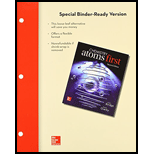
Concept explainers
Interpretation:
The terms chemistry and matter needs to be defined.
Concept introduction:
Chemistry is one of the branches of science, that deals with study of matter and changes that the matter undergoes.
Matter is the one which make our bodies and the entire things we see in entire universe.
Explanation of Solution
Study of matter and changes which the matter undergoes is chemistry. In chemistry we study about molecules, atoms, sub-atomic particles etc. In our day-to-day life we use chemistry in each and every thing. Medicines we take to cure disease are one of the important applications of chemistry. Chemistry makes our life easier.
Anything that has mass and occupies space is known as matter. The entire universe including ourselves is examples of matter. Matter includes atoms and anything made by atoms. The energy phenomena or waves are not considered as matter.
The terms chemistry and matter are defined as above.
Want to see more full solutions like this?
Chapter 1 Solutions
Loose Leaf Version For Chemistry: Atoms First
- 1.74 What are the two properties of ITO that make it serve its function in touch screen applications?arrow_forwardDefine the terms experiment and theory. How are theory and experiment related? What is a hypothesis?arrow_forwardIn Section 1.3 the statement is made that it is worthwhile for scientists, auto mechanics, doctors, politicians, and poets to take a scientific approach to their professions. Discuss how each of these people could use a scientific approach in his or her profession.arrow_forward
- Which of the following are elements, and which are compounds? a NaOH; b BaCl2; c He; d Ag; e Fe2O3.arrow_forward1.71 Is touch screen technology better described as a single design or as a more complex system? Explain your answer.arrow_forward1.75 What does it mean that ITO films are made by deposition? In what phase do materials begin, and in what phase do they end up?arrow_forward
- 1.23 Should the words theory and model be used interchangeably in the context of science? Defend your answer using information found in a web search.arrow_forwardHow does an element differ from a compound? How are they similar?arrow_forward1.80 All molecules attract each other to some extent, and the attraction decreases as the distance between particles increases. Based on this idea, which state of matter would you expect has the strongest interactions between particles: solids, liquids, or gases?arrow_forward
- Chemistry: Matter and ChangeChemistryISBN:9780078746376Author:Dinah Zike, Laurel Dingrando, Nicholas Hainen, Cheryl WistromPublisher:Glencoe/McGraw-Hill School Pub Co
 Introduction to General, Organic and BiochemistryChemistryISBN:9781285869759Author:Frederick A. Bettelheim, William H. Brown, Mary K. Campbell, Shawn O. Farrell, Omar TorresPublisher:Cengage Learning
Introduction to General, Organic and BiochemistryChemistryISBN:9781285869759Author:Frederick A. Bettelheim, William H. Brown, Mary K. Campbell, Shawn O. Farrell, Omar TorresPublisher:Cengage Learning General Chemistry - Standalone book (MindTap Cour...ChemistryISBN:9781305580343Author:Steven D. Gammon, Ebbing, Darrell Ebbing, Steven D., Darrell; Gammon, Darrell Ebbing; Steven D. Gammon, Darrell D.; Gammon, Ebbing; Steven D. Gammon; DarrellPublisher:Cengage Learning
General Chemistry - Standalone book (MindTap Cour...ChemistryISBN:9781305580343Author:Steven D. Gammon, Ebbing, Darrell Ebbing, Steven D., Darrell; Gammon, Darrell Ebbing; Steven D. Gammon, Darrell D.; Gammon, Ebbing; Steven D. Gammon; DarrellPublisher:Cengage Learning  Living By Chemistry: First Edition TextbookChemistryISBN:9781559539418Author:Angelica StacyPublisher:MAC HIGHER
Living By Chemistry: First Edition TextbookChemistryISBN:9781559539418Author:Angelica StacyPublisher:MAC HIGHER Chemistry for Engineering StudentsChemistryISBN:9781337398909Author:Lawrence S. Brown, Tom HolmePublisher:Cengage Learning
Chemistry for Engineering StudentsChemistryISBN:9781337398909Author:Lawrence S. Brown, Tom HolmePublisher:Cengage Learning World of Chemistry, 3rd editionChemistryISBN:9781133109655Author:Steven S. Zumdahl, Susan L. Zumdahl, Donald J. DeCostePublisher:Brooks / Cole / Cengage Learning
World of Chemistry, 3rd editionChemistryISBN:9781133109655Author:Steven S. Zumdahl, Susan L. Zumdahl, Donald J. DeCostePublisher:Brooks / Cole / Cengage Learning





